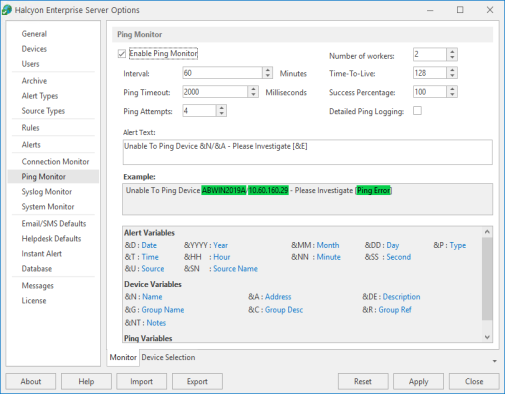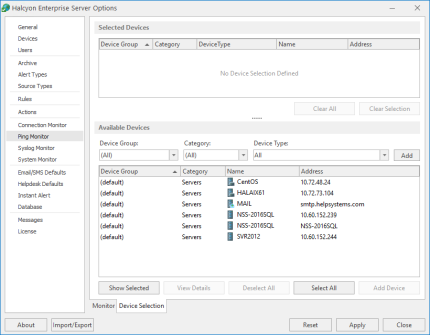Enterprise Server Options - Ping Monitor
These options allow you to ping devices (selected in the Device Selection page) at regular intervals. If a device ping is unsuccessful, an error alert is generated with the error text as specified in the Alert Text field.

There are two tabs of information to complete when specifying Ping Monitor criteria. These are accessed at the bottom of the main display panel.
Settings on this page define how the Ping Monitor operates and the text of any alerts that it generates.
Ping Monitor section
The fields in this section define how the Ping Monitor is configured.
Enable Ping Monitor
Check this box to enable the Ping Monitor and its associated settings.
Interval - Minute(s)
This option sets the ping interval in minutes. The default setting is 60 minutes. Either overtype the current entry or use the up/down arrows to adjust the setting.
Ping Timeout - Milliseconds(s)
This setting defines the time period after which any attempted ping is deemed to have failed. The default setting is 2000 milliseconds. Either overtype the current entry or use the up/down arrows to adjust the setting. .
Ping Attempts
This setting defines how many attempts are made to successfully connect with the device before the alert is raised. The default setting is 4 attempts. Either overtype the current entry or use the up/down arrows to adjust the setting.
Number of workers
This setting defines the number of connections made between the Enterprise Console and the Ping Monitor to ensure a continuous connection is maintained. The range is between 1 and 25 workers. Larger numbers in this field are intended for enterprises that contain many devices that are being simultaneously monitored. Performing a reload of devices from an Enterprise Console client refreshes the list of devices in the monitor and restarts processing.
Time-to-Live
This setting specifies the IP packet time-to-live value. The packet is valid only for the number of router hops specified by this parameter. The default setting is 128 hops.
The time-to-live value acts as a "hop counter". The counter is decremented each time the packet passes through a router or gateway.
Limiting the validity of the datagram by the number of hops helps to prevent internet routing loops. If the value reaches 0 then the packet is dropped and the ping will time-out.
Success Percentage
This setting determines the percentage of attempts required to be successful in order to prevent an alert being generated. The default setting is 4 attempts.
Either over type the current entry or use the up / down arrows to adjust the setting. It is advised that the success percentage is a multiple of the setting in the Ping Attempts field. The default setting is 100%.
Detailed Ping Logging
Enable Detailed Ping Logging in order to capture additional logging information generated by the use of the Ping Monitor.
Alert Text
This is the text message used to report a system monitoring issue. This text can be edited as required. Alert, device and specific system monitor variables can be added to clarify the details of the message.
Example
An example of how the actual alert will be displayed if generated, based upon the text and variables used, is shown in the Example field.
Variables
Ping Monitor substitution variables comprise:
- Alert Variables: (such as Date, Time, Source, Type and so on)
- Device Variables: (such as Name, IP Address, Group Name and so on)
- Ping Variables: (such as Ping Attempts, Failed Attempts and so on)
These variables can be added to the error message as required to identify the name and / or address of devices whose connections are monitored.
The Device Selection tab is used to select the Devices to which the monitor connects and raises alerts if the success percentage figure is not attained.

Selected Devices section
This section shows the devices that are currently selected for use with the monitor. When this tab is opened for the first time, this section is empty.
Information is listed in five columns:
- Device Group: Displays the name of the Device Group to which the device belongs.
- Category: Displays the category in which the device is defined.
- Device Type: Displays the Device Type of the device.
- Name: Displays the name of the device.
- Address: Displays the IP Address or Host name of the device.
Clear All
Click Clear All to remove all of the currently selected devices from selection.
Clear Selection
Highlight a device in the Selected Devices section and click Clear Selection to remove this device from selection. Multiple devices may be selected in one action.
Sorting columns
Column order can be rearranged by left-clicking on a column heading and keeping the mouse button depressed, dragging the column to the new position and releasing the button. Information in each column can be sorted in ascending or descending order by clicking on each column title to change the sequence.
Available Devices section
This section lists all of the devices that have been defined in Device Manager.
Filter options
These options allow the filtering of available devices on the network in order to restrict the list of available devices to just those that meet the filter criteria.
The categories comprise:
- Device Group: Device groups are collections of similar devices, such as all those that belong to a specific department. Device groups are set up and maintained in Device Manager
- Category: Devices, such as servers that can be divided into specific types. Items listed here are by default. No other items can be added to this list.
- Device Type: Device types, such as proxy servers are listed on this drop down and comprise a mix of default items and any other items identified on the network, which are automatically added to this list.
Add Device
To load a device into the Selected Devices section of this page, select the required device in the Available Devices section and click Add Device to move it into the Selected Devices section.
Show/Hide Selected
Click to show in the Available Devices section, only those devices not already listed in the Selected Devices table. This avoids duplicating device information in both tables. Click again to show all available devices, including those that have already been selected.
View Details
This button is used to open the View Device dialog, which displays the attributes of a selected device. No amendments can be made on this display. If changes are required, use Edit Device in Device Manager.
Deselect All
Click to deselect all of the currently selected devices in the Available Devices section.
Select All
Click to select all of the devices listed in the Available Devices section.